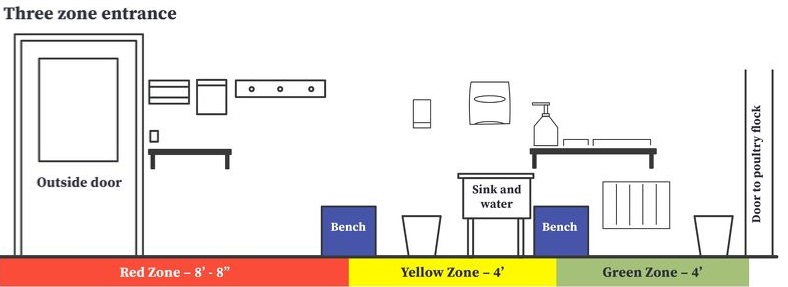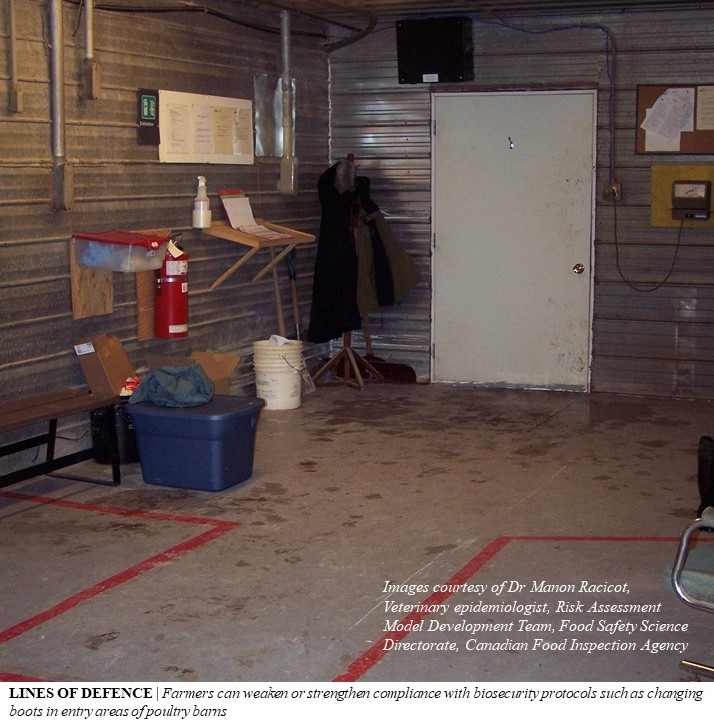



Is your biosecurity as good as you think it is?
Chances are that the biosecurity compliance level on your farm, or the farms in your area, is not up to scratch, no matter where you are located on the planet.Research has shown that observance of biosecurity protocols on poultry farms is a problem all over the globe. And, according to Dr Jean-Pierre Vaillancourt, a professor in the Faculty of Veterinary Medicine at the University of Montreal, Quebec, the issue affects all those who are associated with the industry, whether it’s farm owners, employees or visitors who are failing to comply with biosecurity measures when entering and exiting barns.
“To say that worldwide biosecurity compliance on poultry farms is often incomplete,” he notes, “is the understatement of our times,” says Vaillancourt.
Vaillancourt and Dr Manon Racicot (a veterinary epidemiologist at the Canadian Food Inspection Agency) have observed or officially studied poultry-farm biosecurity compliance for many years (in Vaillancourt’s case, 40 years) all over the world. In Canada, the United States, Europe, South America, Africa and beyond, they’ve seen the same compliance failures. “Problems with compliance is not a cultural thing,” says Racicot, “it’s a human thing.”
Making sure biosecurity measures are carried out correctly and absolutely every time matters. For example, Vaillancourt points out that there have been more cases of avian influenza (AI) in France since 2015 than the total number of cases from 1939 to 2015. “The French government has spent €390 million on control measures and payments to growers but cases are still erupting,” notes Vaillancourt. “High compliance with on-farm protocols must be part of the solution.”
Why compliance fails
From their experience in observing spotty and generally incomplete compliance procedures all over the world, Vaillancourt and Racicot have pinpointed the most common reasons for lapses, and therefore have been able to identify the best methods for preventing biosecurity failures.
One hurdle is a lack of belief that biosecurity measures matter. “I’ve seen it with my own eyes dozens of times. The farmer knows I study biosecurity compliance and you’d think he or she would do a little extra because I’m standing there, but they don’t,” Vaillancourt explains. “They pay lip service to the whole concept. Then there are many producers who want to demonstrate that they know how to handle a visitor like me on the farm; they show me what I need to do but they don’t engage in the same protocols themselves. They don’t see themselves as being a possible source of contamination whatsoever because it’s their farm.”
Biosecurity compliance: starting points for improvement
Here are some further research-based actions to take, from Racicot and Vaillancourt:
Educate your employees:
- The goal is for everyone to consider the farm area a potential biohazard zone at all times.
- Remind them often that biosecurity protocols are as important as duties in the barn.
- It sounds obvious, but demonstrate how to apply all protocols to make sure employees know how to do them correctly by asking them to demonstrate them regularly. Have regular refresher training every three months and also immediate and regular specific training sessions based on any observed non-compliance issues.
- Emphasise that biosecurity measures must be applied with the same rigour no matter the length of the visit or when it occurs.
- Recognise the excellence of highly compliant employees through bonuses, awards and other perks. Have them train other employees.
Physical barn set-up
- Ensure your barn entrance encourages all staff and visitors to follow protocols properly by replacing demarcation lines with a physical barrier such as a bench or wall and door. Make sure there is enough space for at least two people to complete protocols in the change area (yes, you may need to do a renovation). Make sure there are enough tools (sinks, hand washing products, boots, coveralls and so on) at all times, and position them within easy reach.
- Post checklists on each door that will be visible on entering and leaving the biosecurity area so that employees can check off their actions.
Hiring
- Hire with compliance in mind. Vaillancourt and Racicot’s research with psychologist André Durivage found that three personality traits are related to the level of compliance: responsibility, complexity and action-orientation. ‘Complexity’ relates to approaching life with logic and rationality, and those who score high with this trait are more likely to use complex strategies to solve problems, which is needed to correctly apply biosecurity measures. ‘Action-oriented’ folk tend to act energetically when faced with tasks to accomplish and challenges to overcome. Use this information in selecting a poultry-barn manager or worker. Try to determine whether or not the applicants display these traits by asking questions about their general tendencies and attitudes and so on. Personality tests can also be found easily on the internet.
- Reduce turnover by paying people better and providing more benefits. Vaillancourt says compliance would be boosted worldwide if poultry farms had lower turnover.
Visitors
- Visitors must be educated on the spot about protocols and supervised to make sure they follow them. Use only highly compliant employees (which should be everyone after a few months) to escort visitors.
- Keep all barn access doors locked at all times to prevent entry by unauthorised personnel.

Racicot notes that rates of on-farm biosecurity compliance are actually very similar to those related to human health. “It’s the same situation, whether it’s people in a poultry barn failing to do everything needed to protect the health of the flock, or people in their daily lives failing to do things to protect their own health,” she explains, “even if their lives are at risk.”
This leads us to the problem of improper training. Staff may not be informed about biosecurity practices, or how or when they must be carried out. “Lack of knowledge is a big one,” says Vaillancourt. “There is also a lot of staff turnover on some farms and no one is making sure new staff are trained and comply. I’ve spoken countless times to farm workers about certain protocols and they have no idea what I am talking about.”
Vaillancourt observes that many bird catchers don’t know about transmission and survival of salmonella, campylobacter and other infectious diseases. “We underestimate the knowledge level out there,” he says. “And many temporary foreign workers (commonly used in Canada on poultry farms) can’t read English. They are hard workers but if we don’t explain why taking certain actions are important, they won’t take them. And if they don’t see the boss doing it…”
Vaillancourt is also concerned that there has been little analysis done about the success of educational programmes, “so we don’t know if we have the right programmes, if we are connecting with adult learners the right way, and so on”.
The physical set-up in the barn can also impede producers and their employees from using protocols properly every time. This includes a lack of proper signage or supplies and/or inadequate zone partitioning. “The technical staff with the poultry federations in Canada and elsewhere are realising that a line painted on the floor doesn’t work,” says Vaillancourt. “A physical barrier such as a bench or a door cannot be ignored as easily as a line. And if there isn’t the space, that’s another problem.”
He explains that in France, since the AI outbreaks started in 2015, the government paid to have a prefabricated barn entry-building addition designed, with enough space for two zones separated by a bench. Vaillancourt visited four farms with barns equipped with these add-on entrances. Three of the four growers visited actually put on plastic boots in the wrong zone while going into the barns with Vaillancourt.
Even if clean zones and contaminated zones are clearly marked with a bench, or wall and door and there’s enough room for two people to change, Racicot and Vaillancourt’s research shows many poultry farm workers still don’t understand the concept of zones. “Most biosecurity mistakes are related to zoning,” says Racicot. “Not changing boots in the right place for example. It also helps to have three zones: a dirty zone, a transition zone and a clean zone.”
Other factors
Duration of visit
“Generally, we’ve found that when the visit was short (less than 17 minutes), errors were more frequent,” Racicot notes. “Therefore, growers should be emphasising to staff and visitors that length of visit does not matter; the protocols must be the same.”
Clothing
Racicot, Vaillancourt and their colleagues have found that clothing is an important potential source of contamination that is neglected. “However, few farms that we’ve studied required coveralls,” she notes, “and when they did, this measure was often neglected.”
Logbook
Not recording visits in a logbook or not filling it in correctly is a serious biosecurity risk. In Ontario, where a web-based automatic farm-visit tracking system, ‘Be Seen, Be Safe’, is in place (see http://5mpoultry.uberflip.com/i/675016-thepoultrysite-digital-may-2016, page 21), this is not a factor any more. A ‘Be Seen, Be Safe’ pilot programme is beginning soon in Spain.
Cameras and feedback
Racicot and Vaillancourt’s research has also shown that visible cameras only work for a little while to increase compliance, and audits have little impact – as everyone is careful to do things perfectly during an audit but tend to go right back to their old habits afterward. Hidden cameras can be used effectively, but staff will likely not agree to their use unless they are used only to provide feedback and not to punish.
Cooperation in micro-zones
Vaillancourt has been looking at ‘micro-zones’, small eco-areas of four or five farms where disease could easily be spread. “What can be done collectively to reduce risk in these areas?” he asks. “It may be valuable in some cases to use a mediator to communicate about shared actions if neighbours don’t get along.”
Vaillancourt concludes with the thought that much of biosecurity compliance comes down to effort. “If it’s easy to comply, people will comply,” he says. Racicot wants everyone in the industry to know that many actions must be taken on every farm if the global level of poultry-farm biosecurity compliance is going to rise significantly. “No one action,” she says, “will solve the problem of low compliance.”
This article originally appeared in the July 2017 edition of The Poultry Site Digital. To read other articles from this issue, themed around 'biosecurity', click here.









.jpg)


